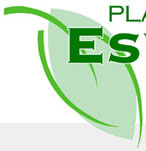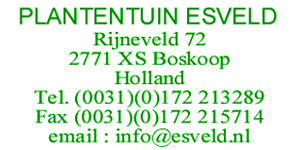Welcome on the site of Plantentuin Esveld. This is the old site and does not get updated anymore! click here to go to the new and much improved site.
click on the groupcode of the rhododendron you are looking for
Rhododendron : 1A
Group 1a: Rhododendron ponticum. Evergreen shrubs, often as high as wide, up to 3 or 4 meters. Flowers in rather tight trusses, rather small-flowered, in many different colours, profusely flowering. Leaves elliptical, dark green, more or less shining. Underside glabrous. Rhododendron : 1B
Group 1b: Rhododendron caucasicum. Like the preceding group, but less tall and flowering much earlier, often already at the end of March, pink to white. Leaves dull green, broadly elliptical, underside glabrous. Rhododendron : 1C
Group 1c: Rhododendron smirnowii. Also like the preceding groups. The leaves show a covering of feltlike hairs at the underside (indumentum). They are usually late flowering, pink to purple, rather shy. Rhododendron : 2A
Group 2a: Rhododendron catawbiense. Vigorously growing evergreen shrubs up to 4-5 m. The flowers are borne in tight trusses in many colours except yellow. Flowering period is May; they all are free-flowering. Leaves ovate to broadly elliptical, slightly convex, dark to fresh green, underside glabrous. Rhododendron : 2B
Group 2b: Rhododendron maximum. Closely related to the preceding group with many equal characteristics. Flowering very late, end of May, early June, shy flowering. Leaves broadly elliptic, dull gray-green, underside glabrous. Rhododendron : 3A
Group 3a & 3b: Rhododendron yakushimanum. Rhododendron yakushimanum are rather low, more or less spreading evergreen shrubs up to 125 cm. Leaves oval to obovate, dull green to graygreen. Underside covered with a yellowish indumentum or only sparsely so, sometimes glabrous. Flowers in tight trusses in pastel-colours, fading to white or light pink. Flowering period beginning to mid May, usually free flowering. Rhododendron : 3C
Group 3c: Rhododendron makinoi. Closely related to the two preceding groups. The main difference is the shape of the leaves, being knife-like, very narrow and clad with a firm indumentum. Rhododendron : 4
Group 4: Rhododendron arboreum. Small trees or large evergreen shrubs up to 5 metres. The leaves are rather big, dark green and usually ovate, sometimes a bit silvery at the underside. The flowers are borne in firm umbels, usually red or dark pink, rarely pink or white, never yellow. Flowering season is mid-April to May. Almost all cultivars need winter shelter. Rhododendron : 5
Group 5. Rhododendron insigne. Rather low, spreading shrubs up to 2.5 metres. The leaves are oval-pointed and rather hard. The underside is usually silvery-white and glabrous. The flowers are in open trusses, 5 to 8 per truss. The colours range from white to dark pink, never red or yellow. Many cultivars are flowering rather shy as young plants. All are fully winterhardy and mostly beautiful foliage-plants. Rhododendron : 6
Group 6: Rhododendron strigillosum, facetum and elliottii. This group includes a large number of evergreen trees and shrubs, not winterhardy, except in very sheltered areas. The leaves vary greatly. The flowers are almost always flaming red, in rather open trusses. Flowering period is April to early May. All cultivars mentioned need at least some shelter in winter. Rhododendron : 7
Group 7: Rhododendron griersonianum. This species has been used frequently in hybridising and many different cultivars have been raised. The leaves are usually lanceolate, light green and pubescent. The flowers are borne in rather loose trusses in red, rose or orangered. There is no yellow, purple or white in this group. Most hybrids are rather tall and untidy shrubs, there are also several dwarf forms. Flowering period is May, many of these hybrids need shelter in less favorable localities. Rhododendron : 8A
Group 8a: Rhododendron griffithianum. Large shrubs or small trees up to 6 m. The leaves are oblong-elliptical, dark green. Many of these hybrids do not have dense foliage and usually they are sparsely branched. The colours are white to dark pink or salmon. There is no yellow, purple or red. Most varieties are hardy enough in England and comparable countries. Rhododendron : 8B
Group 8b: Rhododendron orbiculare. A small group of evergreen shrubs, up to 2 m. Leaves almost orbicular and glabrous. Flowers bell-shaped, up to 8 in loose trusses, pink. Rather demanding in cultivation. Flowering period is April-May. Rhododendron : 9
Group 9: Rhododendron fortunei. Large evergreen shrubs or even treelike, up to 5-6 m. Leaves broadly oblong to oblong-elliptic, fresh green. Flowers in rather firm trusses, sometimes fragrant. The colours are pink, dark pink, white, cream or lilac, never red or purple. Many of these hybrids are only sparsely branched and do not form flowerbuds in a young stage. Flowering season is May. Rhododendron : 10
Group 10: Rhododendron campylocarpum. Medium-sized evergreen shrubs up to 3 m high, usually well-branched. The leaves are eggshaped or almost orbicular, glabrous, dark green. Flowers are bell- or funnelshaped, in umbels of 5-8 corollas, yellow, cream, salmon or salmonpink. Most varieties in this group are difficult to grow and to keep in good health. Flowering season is April-May. Rhododendron : 11
Group 11: Rhododendron wardii. Comparable to the preceding group 10. Most of these hybrids are hardier and set more flowerbuds. They are less difficult to establish. The colours are mostly yellow, cream or salmon, often with a small red blotch. Flowering period is May. Rhododendron : 12A
Group 12a: Rhododendron thomsonii. There are only a few hybrids in this group of evergreen, large shrubs. The leaves are more or less orbicular to oblong, glabrous. Flowers in somewhat open trusses, bell- or funnelshaped, almost always red. Most of these hybrids require a sheltered place in woodland conditions. Flowering in April-May. Until 2003 there are no varieties in this group available. Rhododendron : 12B
Group 12b: Rhododendron viscidifolium. Only one hybrid with excellent foliage and splendid orange-salmon flowers. Fully hardy and flowering in May. Rhododendron : 13
Group 13: Rhododendron williamsianum. Rhododendron williamsianum is one of the best parents for hybridising, in order to obtain dwarf or semi-dwarf varieties. They are well-branched shrubs, up to 2 m. high, but often less than that. The leaves are typically oblong to orbicular, fresh green. Flowers bell-shaped, in loose trusses, usually pink, sometimes lilac, white or cream, never red or purple. Flowering season is April-May. Most varieties are good for plantations in the foreground of larger plants. All are winterhardy. Rhododendron : 14A
Group 14a: Rhododendron neriiflorum and R. haematodes. Small shrubs, evergreen, up to 1 m. Leaves dull green, usually with a grey indumentum. Flowers bell-shaped in loose umbels, usually red. Shelter in winter is advisable in rough conditions. Rhododendron : 14B
Group 14b: Rhododendron sanguineum. Small group of rare hybrids, evergreen, usually dwarfs or even almost prostrate. Leaves egg-shaped, with a silvery indumentum, often touched by disease. Flowers in looses umbels of 4-6 corollas, dark red. All these varieties are difficult to grow and are only suitable for experienced gardeners. Rhododendron : 15
Group 15: Rhododendron dichroanthum. Medium-sized shrubs of compact habit. Leaves rather small, with silvery underside. Flowers in small umbels of 6-7 corollas, yellow, orange, salmon or rarely red. Most of these varieties are only suitable for experienced gardeners. There are some well-growing varieties. Rhododendron : 16
Group 16: Rhododendron forrestii (R. repens). A large group of evergreen shrubs usually not higher than 1 meter. The leaves are oblong, dark green. Flowers in loose umbels, always red. Very suitable in front of larger hybrids. All are winterhardy and easy to grow. Rhododendron : 17
Group 17: Rhododendron with beautiful leaves. This group includes species and cultivars, excelling by their beautiful foliage, the flowers are usually less important. The habit and growth are quite different, as is the rate of difficulty in cultivation. You can find more information and also pictures in the books Rhododendron Portraits and Encyclopedia of Rhododendron Species. Rhododendron : 18
Group 18: Tree-like Rhododendrons. This group includes the tree-like species, many of them not suitable for a rough place. Nevertheless, quite a few of them are magnificent in milder locations in Great Britain. See also the books Rhododendron Portraits andEncyclopedia of Rhododendron Species Rhododendron : 19
Group 19: Other elepidote Rhododendrons. See the Encyclopedia of Rhododendron Species. Rhododendron : 20
Group 20: Small lepidote Rhododendrons. Small and compact evergreen bushes with small lepidote oval leaves. Small-flowered, funnel-shaped in small trusses, aromatic, lilac to purple, never pink or red. Most of these varieties are excellent plants for the rock garden. Flowering season April-May. Rhododendron : 21
Group 21: upright growing, small-leaved bushes. Upright growing evergreen bushes, up to 3 m high, with rather small leaves and flowers. The leaves are oblong, usually acuminate, and lepidote. The flowers are small, also in small trusses,, lilac through bluish to purple, rarely white or dark red, never pink. Several varieties are spectacular, others have only a botanical value. Rhododendron : 22
Group 22. Rhododendron cinnabarinum. This group has about the same characteristics as in group 21. The corollas are bell-shaped and pendant, borne in small umbels; yellow, yellow-orange to red, rarely lilac or white. Shelter in winter is needed unless in mild locations. Flowering period is May. Rhododendron : 23
Group 23: Rhododendron racemosum Upright growing, evergreen shrubs with usually small leaves. The flowers are produced out of axillary buds, quite small, in pink, salmon or yellow. Rather heavy pruning may be necessary to keep them in shape. Flowering period April-May. Rhododendron : 24
Group 24: Rhododendron dauricum and carolinianum Medium-sized shrubs, usually evergreen. The leaves are extensively aromatic. The flowers are borne in small umbels, funnel-shaped, lilac, violet, rosy-lilac or white, never red or yellow. Flowering season March-April. Rhododendron : 25
Group 25: Rhododendron keiskei Small, low shrubs, up to 1 meter, evergreen. The leaves are oblong, with somewhat acuminate apex, grey-green with a brownish hue. Flowers in small trusses, always yellow or cream. Valuable plants for the rock garden. Flowering season April-May. Rhododendron : 26
Group 26: Other lepidote Rhododendrons. Rhododendron : 27
Group 27: Azaleodendron A small group of hybrids between 'true' Rhododendrons and the so called Azaleas. Interesting for the collector. Most of them flower late in the season and are inconspicuous. Rhododendron : 28A
Group 28a: Azalea mollis Pubescent leaves, flowers orangered, light red, orange, pink or yellow. No white, lilac or purple. Flowering early May, slightly fragrant. Many older cultivars are no longer available. Rhododendron : 28B
Group 28b: Knap Hill-Exbury Azalea Like group 28a, with more variety in colour such as dark red, white with yellow blotch, dark yellow. Not fragrant, flowering season May. Rhododendron : 28C
Group 28c: Pontica Azalea Hardy Ghent Azaleas, developed in the 19th century. The flowers are medium sized, trumpet-shaped, never white. The flowering period is during the development of the new foliage. They are not or only scarcely fragrant. Flowering period is mid-May. Rhododendron : 28D
Group 28d: Rustica Azalea Closely related to the preceding group. The flowers are double and the growth is larger. Rhododendron : 28E
Group 28e: viscosa and occidentalis Azalea Descendants of the fragrant American species R. viscosum and R. occidentale. They flower late in the season, together with the developing new foliage and are strongly fragrant. Rhododendron : 29A
Group 29a: Rhododendron kiusianum Very small-leaved and quite small flowers, low growing. Rhododendron : 29B
Group 29b: Kurume-Azalea Kleinblättrig und kleinblumig bis 1 m. hoch. Rhododendron : 29C
Group 29c: Large-flowered Japanese Azalea Large-flowering, dropping quite a few leaves in winter. Rhododendron : 29D
Group 29d: Rhododendron nakaharae Flowering late, and almost creeping. Only in red, pink and orange. Rhododendron : 29E
Group 29e: Satsuki-Azalea Large-flowered, often not very hardy. Rhododendron : 29F
Groep 29f: Other evergreen Azaleas A small group of species, mostly small shrubs, requiring more care than usual Rhododendron : 30
Group 30: Other Rhododendrons This group includes mostly of species and cultivars suitable for the real specialist. The conditions in the garden must be extremely good and well-controlled to achieve results. Rhododendron : 31
Group 31: Ledum This group includes the former genus Ledum, which is now included in Rhododendron. Open the chapter rhododendrons by group as 1 file.
Return to the main page | 














